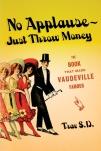In 1919 there were close to 1,000 vaudeville houses in the country. By 1921, it is estimated that a quarter of theatres which had played both films and vaudeville dropped the vaudeville shows. The new vogue was for “presentation houses”: large movie palaces, that would also present live entertainment, such as big bands, and popular comedy acts.
Such places were huge—the Capitol Theatre (1919) sat 5,300 people. Loew’s State, the Loew’s chain’s 1921 flagship, had 3,500 seats. Others included the Paramount, the Strand, and the Roxy. “Don’t get caught on the Roxy Stage without bread and water,” Joe Frisco joked. George Burns joked that he couldn’t see the audience across the orchestra of one of these houses it was so large.
At the Capitol Theatre in 1932 you might see a film surrounded by a bill that included Burns and Allen, Arthur Tracy, Cab Calloway and 6 other acts. In time, all but the big bands and their singers (and the movie, of course) were phased out of most of the big presentation houses. Through the 1940s you could see the likes of Bing Crosby, Frank Sinatra, Kate Smith and Judy Garland (and the big swing bands that accompanied them) at the presentation houses. Nothing else would fill the room! They were all shut down by 1948, as the trend toward specialization continued, with the big bands booked in dance halls and night clubs, and movie theatres evolving into the specialized venue we know today, with no stage, just a flat screen on the wall in front of the audience. Radio City Music Hall, home of the Rockettes (built 1932) is the last remaining presentation house.
To learn more about presentation houses, vaudeville, and the variety arts past and present, consult No Applause, Just Throw Money: The Book That Made Vaudeville Famous, available at Amazon, Barnes and Noble, and wherever nutty books are sold.


